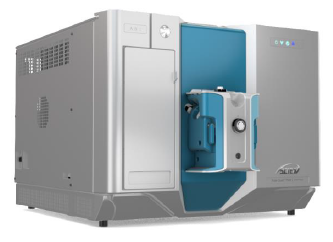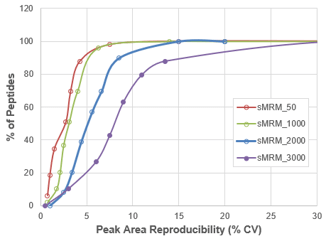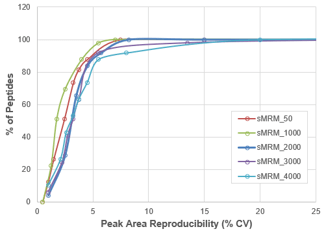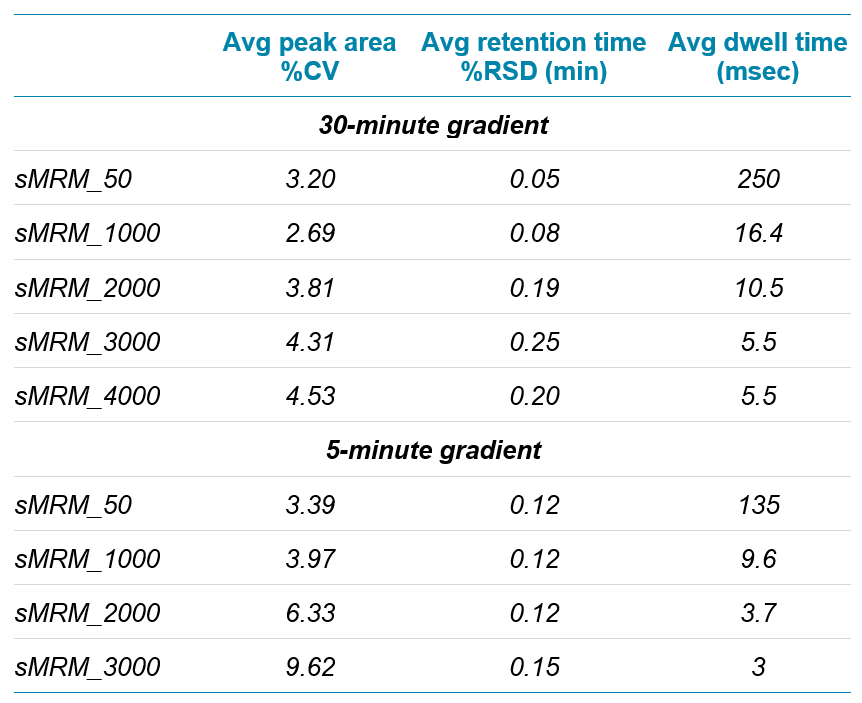Methods
Sample preparation: A simple mixture of PepCalMix and digested beta-galactosidase (SCIEX), and a digest of bovine serum albumin was prepared at 1 fmol/µL. Samples were prepared both in buffer and spiked into digested human K562 cell line sample.
Chromatography: Sample separation was performed in trap elute mode using the ACQUITY UPLC M-Class System (Waters) operated at 5 µL/min.3 A 5 and 30 minute linear gradient was used to separate the peptides, on a Phenomenex C18 column (Luna Omega Polar, 150 x 0.3mm, PHX P/N 00F-4760-AC). Column temperature was maintained at 30 ºC. A 6 µL injection was performed.
Mass spectrometry: Data was acquired using the SCIEX Triple Quad 7500 system, controlled by SCIEX OS Software. The OptiFlow Pro Ion Source was used, using the microflow probe and microflow E Lens Technology. Using the Scheduled MRM algorithm, a series of methods with increasing numbers of MRMs were tested to assess assay reproducibility with increasing multiplexing.
Data processing: All data was processed using Analytics in SCIEX OS software using the AutoPeak Algorithm.4
Good chromatography is key for highest multiplexing
To analyze the increasing numbers of analytes in a single targeted MRM assay, high quality, highly reproducible chromatography is essential. One of the user inputs for the Scheduled MRM Algorithm is Retention Time Tolerance. Here, the peak width at base and the observed retention time variance per peptide was used to compute a retention time tolerance. Of course the tighter both of those LC attributes were per peptide, the more narrow the retention time tolerance was in the method. Using microflow chromatography, very high quality chromatography was achieved (Figure 2 and 5). The average retention time %RSD observed for the 15 replicates analyzed using each method was 0.13% and 0.15% for both the 5- and 30-min gradients. This means most peaks were shifting by less than 2 seconds across the replicates.
Shown in Figure 3 is a simulation of the MRM concurrency for increasing numbers of MRMs when running a 30-minute gradient (concurrency being the number of MRMs to be monitored at any point in time). Because the chromatography was very good, up to 4000 MRM transitions could be run in the single method and still maintain lower concurrency (top figure) as well as higher dwell times (bottom figure). The dwell times to be used in the method is computed and displayed in SCIEX OS Software in sMRM Summary to help with method development.2 Keeping the dwell times above 5 or 10 msec ensures the quantitative data is of high quality especially for the low abundant precursors.
Effect of scheduling on quantitative reproducibility
An experiment was designed to assess the effects of higher MRM multiplexing on analytical reproducibility (Figure 4) on the SCIEX Triple Quad 7500 LC-MS/MS System − QTRAP Ready. MRM transitions of 50 tryptic peptides were developed and tested for reproducibility (sMRM_50). Next, random MRM transitions and retention times were computed and added to the 50 real MRM transitions to create assays with 1000, 2000, 3000 and 4000 MRM transitions using the Scheduled MRM Algorithm. The reproducibility of the 50 real MRM transitions from each method across the replicate injections was used as a measure of the analytical reproducibility of each acquisition method, for peak area and retention times.
These assays were tested for reproducibility by measuring the peak areas and retention times for the 50 tryptic peptides across the 15 replicates for each of the assays (Figure 4). Plotting the cumulative %CV curves allows easy visualization of the impact of increasing numbers of MRMs per assay. For the 30-minute gradient across all of the assays, ~85-90% of peptides showed %CV of <5%. Table 1 highlights the average MRM peak area %CVs, the retention time reproducibility as well as the average dwell time per assay.
Enabling faster chromatography
In addition to using the Scheduled MRM algorithm to increase multiplexing, it can also be used to increase the gradient speeds used in quantitative experiments. An experiment was performed using a 5 minute gradient, and again increasing numbers of MRM transitions were run in replicate. (Figure 1, Table 1). In this case, the 3-protein digest was spiked into digested human cell lysate to account for any matrix effects. Again, good data reproducibility was obtained with up to 3000 MRM transitions in a 5 minute gradient, with average peak area %CV below 10%. This high quality data was possible because of the sensitivity the SCIEX 7500 system and the reproducible chromatography that allowed the use of narrow retention time tolerances (Figure 5).
Powerful software for MRM data processing
SCIEX OS software provides a comprehensive package for the acquisition and processing of peptide quantification data from large scale MRM experiments. As mentioned above, assay development is streamlined with the ability to view the impact of method settings on the computed dwell times across the method. Using the Analytics module for data processing, reproducible peak integrations of MRM assays using AutoPeak Algorithm is very automated, enabling streamlined and rapid quantitative data processing.4 Because of its ability to support many samples and highly multiplexed peptide MRM experiments, the software is ideal for biomarker verification assays, tracking changes in post-translational modifications (e.g. phosphorylation) across different samples, biological pathway analysis, and other targeted peptide quantitative assays.
Conclusions
Using the Scheduled MRM algorithm to build MRM acquisition methods provides tremendous advantages for the generation and use of MRM assays. It allows a higher number of transitions to be monitored concurrently without having to resort to shorter dwell times or longer cycle times. This ensures that the analytical reproducibility of the MRM assays is maintained at even 4000 MRM transitions during a single LC run.
The sensitivity and quantitative reproducibility of the SCIEX Triple Quad 7500 system enables very good peak reproducibility to be observed even with very high numbers of MRM transitions in a single assay. Coupled with highly reproducible microflow chromatography, this LC-MS/MS system provides a powerful tool for large scale peptide quantification for targeted biomarker research.

 Click to enlarge
Click to enlarge Click to enlarge
Click to enlarge Click to enlarge
Click to enlarge Click to enlarge
Click to enlarge Click to enlarge
Click to enlarge Click to enlarge
Click to enlarge